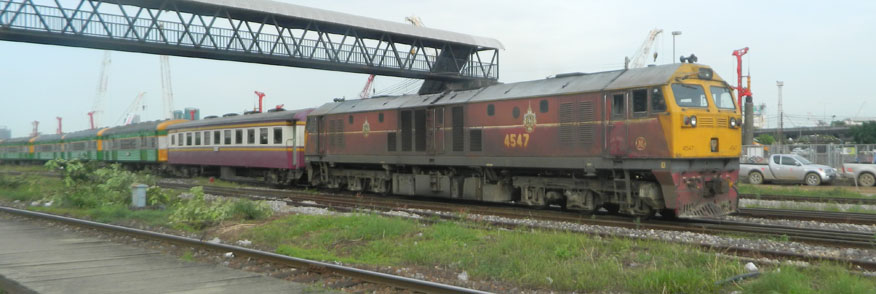|
History
The State Railway of Thailand (Thai: การรถไฟแห่งประเทศไทย) is the state-owned rail operator in Thailand. The network sees around 50 million passengers per annum.
SRT was founded as the Royal State Railways of Siam (RSR) in 1890. Construction of the Bangkok-Ayutthaya railway (71 km or 44 mi), the first part of the Northern Line, was started in 1891 and completed on May 23, 1892. The Thonburi-Phetchaburi line (150 km or 93 mi), later the Southern Line, was opened on June 19, 1903.
The Northern Line was originally built as 1,435 mm (4 ft 8 1⁄2 in) standard gauge, but in September 1919 it was decided to standardize on 1,000 mm (3 ft 3 3⁄8 in) meter gauge and the Northern Line was regauged during the next ten years. On July 1, 1951, RSR changed its name to the present State Railway of Thailand.
In 2005 SRT had 4,070 km (2,530 mi) of track, all of it meter gauge. Nearly all is single-track, although some important sections around Bangkok are double or triple-tracked and there are plans to extend this.
Issues
The SRT has long been popularly perceived by the public as inefficient and resistant to change. Trains are usually late, and most of its equipment is old and poorly maintained. The worst financially performing state enterprise, the SRT consistently operates at a loss despite being endowed with large amounts of property and receiving large government budgets; it reported a preliminary loss of 7.58 billion baht in 2010. Recurring government attempts at restructuring and/or privatization throughout the 2000s have always been strongly opposed by the union and have not made any progress.
A Case in point.......
During a quiet week in October 2013 I decided to venture to Bang Sue Junction for the afternoon. I had arrived by aircon’ bus and the MRT connecting via the BTS stop at Chatuchak Park. It took an hour and a half at a cost of 35 baht. Returning by this route in early evening is a different matter; there are long queues for all transport options out of the city. Getting change from two hours would be difficult. Already on the platform I decided to take a commuter train for part of my journey out of the city. The experience summed up all there is to know about the SRT Ordinary Service which uses the most outdated of equipment. The Service 313 departed from Bang Sue at 17.14: The journey to Don Mueang about half an hour. The commuter service would terminate at Baan Phachi in Saraburi Province. The first point to remember is that this service is free for Thai people but farang (foreigners) will have to pay. When I called at the ticket office to get my ticket I was charged 3 baht. This would hardly pay for the paper the ticket was printed on or the system that provided it, let alone the staff wages. The 313, as expected, was crowded but I was happy to stand in the exit doorway. However on exiting Bang Sue station what I hadn’t expected was a theme-park ride. From my position between the last two carriages I’m sure at one stage I was airborne. The train arrived at Don Mueang much as expected which is more than can be said for those gridlocked on Bangkok’s roads.
|
Orientation (Bangkok Main Stations)
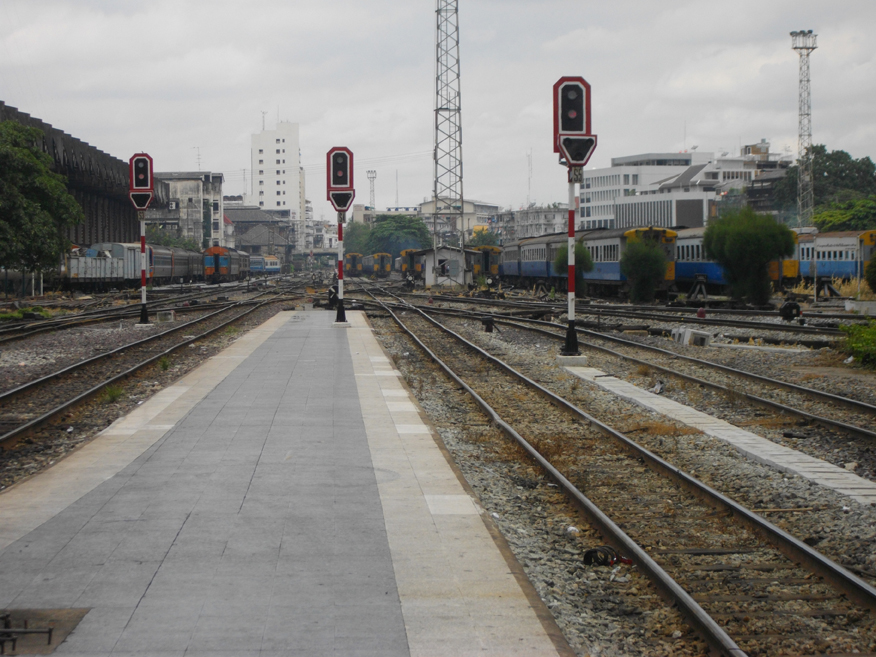
 Hua Lamphong……….Bangkok’s mainline terminus is at Hua Lamphong which will reach its centenary in the next couple of years. For a sprawling metropolis as the capital is now this is totally inadequate 100 years on. In 1900 Bangkok was in its infancy. After the sack of Ayutthaya in the 18th century the capital had initially moved to Thonburi on the western side of the Chao Phraya River and the drainage basin to the east was largely undeveloped. Now with the city sprawling for tens of kilometres to the north and east the mainline station is buried deep in the old city where Chinese settlers had begun to drain the land and develop their businesses.
Hua Lamphong……….Bangkok’s mainline terminus is at Hua Lamphong which will reach its centenary in the next couple of years. For a sprawling metropolis as the capital is now this is totally inadequate 100 years on. In 1900 Bangkok was in its infancy. After the sack of Ayutthaya in the 18th century the capital had initially moved to Thonburi on the western side of the Chao Phraya River and the drainage basin to the east was largely undeveloped. Now with the city sprawling for tens of kilometres to the north and east the mainline station is buried deep in the old city where Chinese settlers had begun to drain the land and develop their businesses.
In consequence of all this, with no tunnels or rail bridges in place trains running in all directions from Hua Lamphong take up to an hour to clear Bangkok’s busy streets. Due to the distances involved trains tend to run through the night; often passengers wishing to avoid the heat of the day. For example on the Southern Line the special express train 37 (neither special nor express) departs Hua Lamphong at 15.10 arriving at Sungai Kolok on the Malaysian border at 11.20 the following day. Understandably most of the traffic at Hua Lamphong is concentrated from early to mid morning for arrivals and mid afternoon till late evening for departures.
Thonburi and Mae Klong Line……….These two stations are on the western side of the Chao Phraya River but between them handle only a small fraction of traffic compared with Hua Lamphong. Thonburi station does connect with SRT’s southern line at Taling Chan Junction while the Mae Klong Line is an independent line which runs from Wongwian Yai to Mae Klong, albeit with a break at Maha Chai as there is no railway bridge across the Krachin River.
Orientation (SRT Main Lines)
Apart from the Mae Klong Line the STR network divides into regions each using Hua Lamphong as its terminus. These are clockwise, Southern Line, Northern Line, Northeastern Line and Eastern Line.
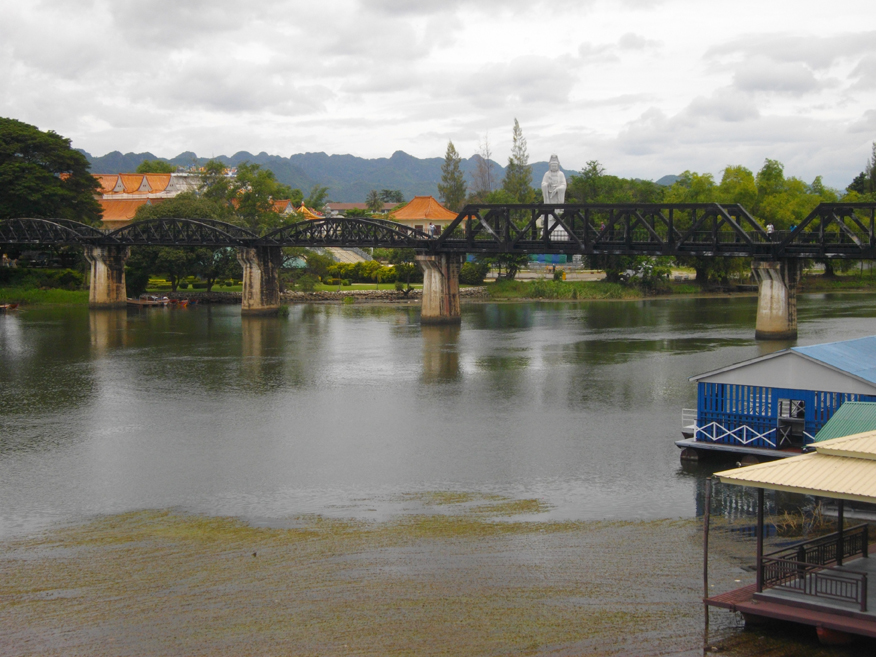 Southern Line……….The Southern Line is easily the longest of the regional lines and services trains all the way to the Malaysian border. With only a single track though there is no high-speed service so understandably progress is slow. From Hua Lamphong southern trains first head north taking about 30 minutes to reach Bang Sue Junction where they head west across the Chao Phraya River into Nonthaburi Province, through Taling Chan Junction which receives trains from Thonburi, on to Nakhon Pathom and into Ratchburi Province where the line again divides at Nong Pladuk with a spur to Suphan Buri. Still in Ratchburi Province the line divides once more at Ban Pong. This time a branch line connects with Kanchanaburi and on across the River Kwai Bridge to Nam Tok station at Sai Yok. This is the route of the railway built by the Japanese in WW2 using countless POWs as forced labour. Note: Kanchanburi trains do not depart from Hua Lamphong but from Thonburi Railway Station.
Southern Line……….The Southern Line is easily the longest of the regional lines and services trains all the way to the Malaysian border. With only a single track though there is no high-speed service so understandably progress is slow. From Hua Lamphong southern trains first head north taking about 30 minutes to reach Bang Sue Junction where they head west across the Chao Phraya River into Nonthaburi Province, through Taling Chan Junction which receives trains from Thonburi, on to Nakhon Pathom and into Ratchburi Province where the line again divides at Nong Pladuk with a spur to Suphan Buri. Still in Ratchburi Province the line divides once more at Ban Pong. This time a branch line connects with Kanchanaburi and on across the River Kwai Bridge to Nam Tok station at Sai Yok. This is the route of the railway built by the Japanese in WW2 using countless POWs as forced labour. Note: Kanchanburi trains do not depart from Hua Lamphong but from Thonburi Railway Station.
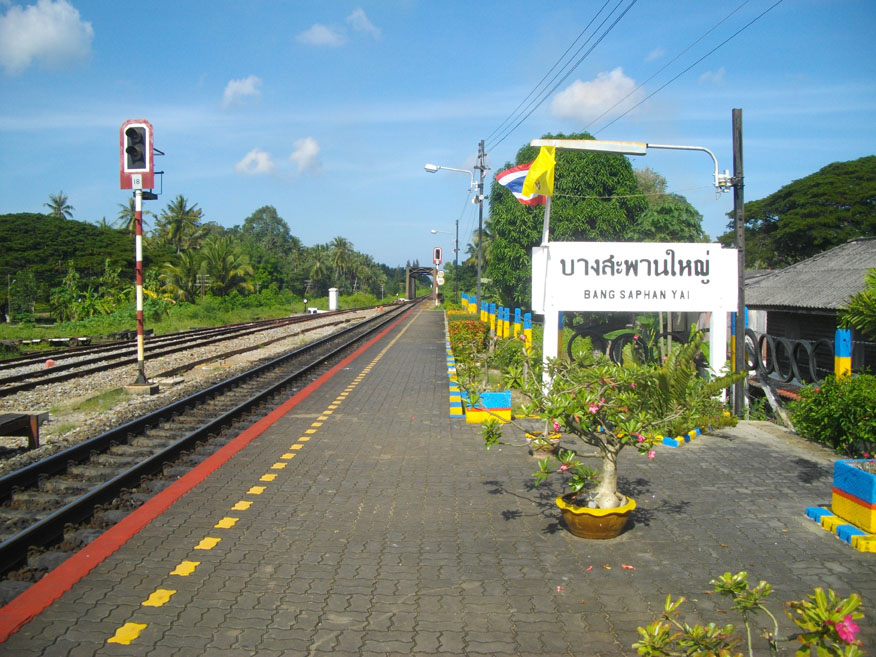 At Ban Pong the main line turns south and makes its way down the Malay Peninsula taking in the provinces of Petchaburi, Prachuap Kiri Khan, Chumphon, Surat Thani and Nakhon Si Thammarat.
At Ban Pong the main line turns south and makes its way down the Malay Peninsula taking in the provinces of Petchaburi, Prachuap Kiri Khan, Chumphon, Surat Thani and Nakhon Si Thammarat.
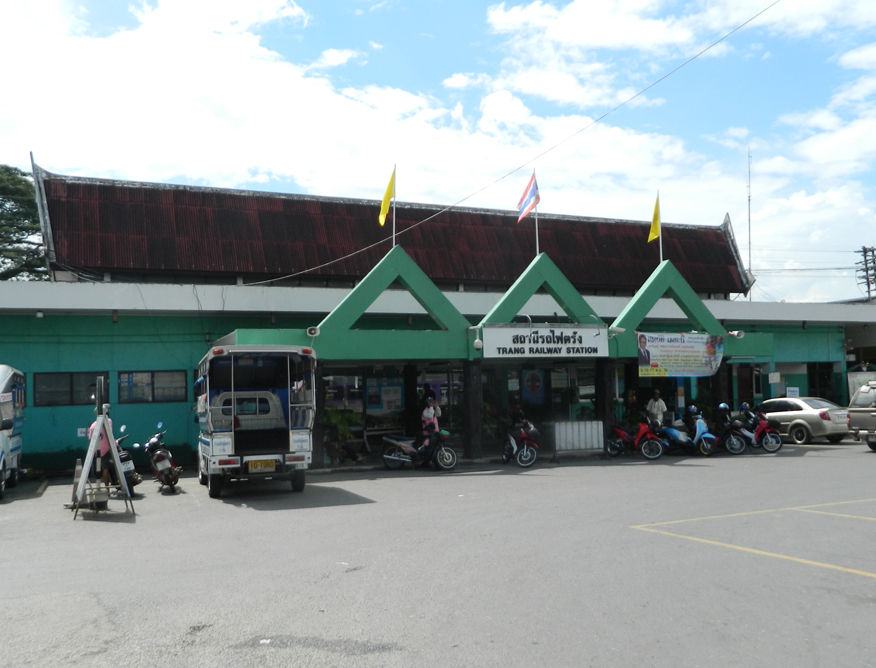 At Thung Song Junction the line divides with a branch line servicing Trang and Kantang. Still in Nakhon Si Thammarat Province a spur connects the provincial capital with the main line at Khao Chum Junction. The main line continues through Phattalung Province and into Hat Yai, an important transport hub. Here there is an option to reach Songkhla on the coast but the main line splits in two with both reaching the Malaysian border. The eastern section continues on into the provinces of Pattani, Yala and Narathiwat where the Southern Line terminates at Sungai Kolok. The much shorter western section reaches the border at Sadao where through trains to Butterworth and beyond pass.
At Thung Song Junction the line divides with a branch line servicing Trang and Kantang. Still in Nakhon Si Thammarat Province a spur connects the provincial capital with the main line at Khao Chum Junction. The main line continues through Phattalung Province and into Hat Yai, an important transport hub. Here there is an option to reach Songkhla on the coast but the main line splits in two with both reaching the Malaysian border. The eastern section continues on into the provinces of Pattani, Yala and Narathiwat where the Southern Line terminates at Sungai Kolok. The much shorter western section reaches the border at Sadao where through trains to Butterworth and beyond pass.
The Southern Line is long due for an upgrade and SRT have announced plans for the main line to be converted to dual track and electrified. At this point in time I am awaiting a timetable for this work to be completed.
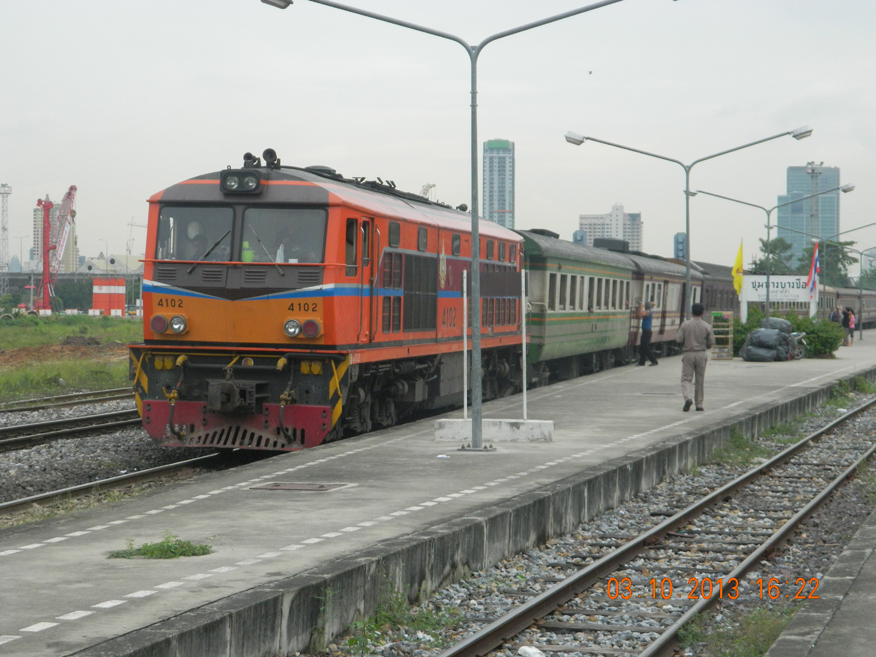 Northern Line……….The Northern Line originates along with other regional lines at Hua Lamphong and terminates at Chiang Mai Railway Station. Like the Southern Line it makes its way north towards Bang Sue Junction. Here it is served by a separate station with platform and ticketing. Passengers should note that if arriving at Bang Sue by bus or taxi, or indeed via the MRT they will find themselves at Station number 2 which is for southern trains. The Northern Line station is to the right and involves a short walk, crossing the track onto the platform to the right. Don’t worry; remember express trains are not really ‘express’ and the line not electrified.
Northern Line……….The Northern Line originates along with other regional lines at Hua Lamphong and terminates at Chiang Mai Railway Station. Like the Southern Line it makes its way north towards Bang Sue Junction. Here it is served by a separate station with platform and ticketing. Passengers should note that if arriving at Bang Sue by bus or taxi, or indeed via the MRT they will find themselves at Station number 2 which is for southern trains. The Northern Line station is to the right and involves a short walk, crossing the track onto the platform to the right. Don’t worry; remember express trains are not really ‘express’ and the line not electrified.
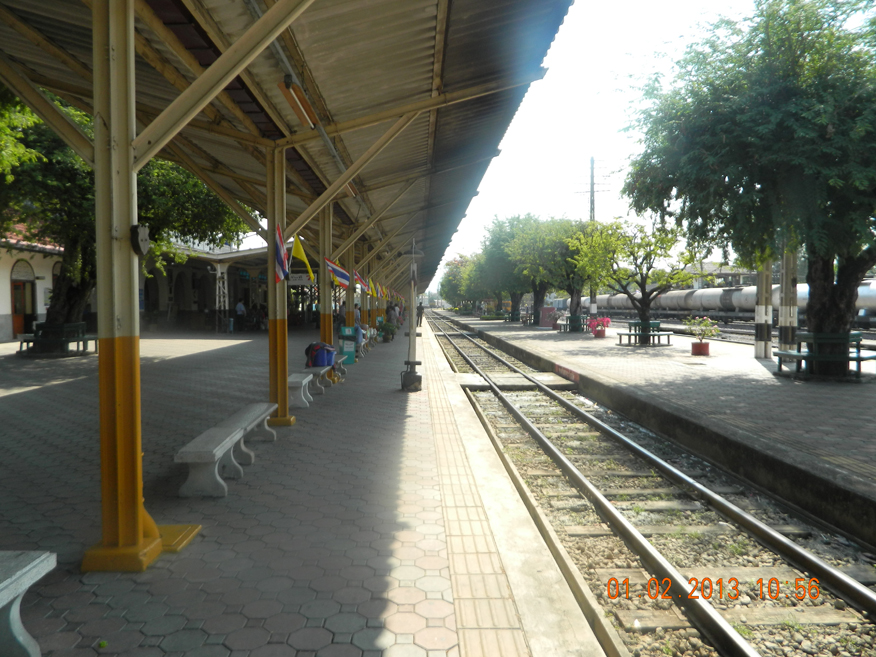 From Bang Sue the line heads north past Don Meuang Airport and out through Prathum Thani Province into Ayutthaya. Before leaving this Province the line divides at an important junction at Ban Phachi. Here the Northern Line splits from the Northeastern Line. From Ban Phachi the line heads briefly into Saraburi Province then north through the provinces of Lopburi, Nakhon Sawan, Phichit, Pitsanulok and Uttaradit. At Ban Dara Junction in Uttaradit Province a branch line serves Sawankholok which has an airport. From Ban Dara Junction the line enters the northern mountainous region. As reported in my Lastest News section on 9 September, all train bound for Chiang Mai currently terminate here at Sila-At while repairs are carried out further upline. After Sila-At the line enters the province of Phrae then onto Lampang, Lamphun and finally Chiang Mai.
From Bang Sue the line heads north past Don Meuang Airport and out through Prathum Thani Province into Ayutthaya. Before leaving this Province the line divides at an important junction at Ban Phachi. Here the Northern Line splits from the Northeastern Line. From Ban Phachi the line heads briefly into Saraburi Province then north through the provinces of Lopburi, Nakhon Sawan, Phichit, Pitsanulok and Uttaradit. At Ban Dara Junction in Uttaradit Province a branch line serves Sawankholok which has an airport. From Ban Dara Junction the line enters the northern mountainous region. As reported in my Lastest News section on 9 September, all train bound for Chiang Mai currently terminate here at Sila-At while repairs are carried out further upline. After Sila-At the line enters the province of Phrae then onto Lampang, Lamphun and finally Chiang Mai.
Under the projections made by SRT electrification of the Northern Line is a key component of their master plan. They would build the new line alongside the existing line as far a Uttaradit but under the proposals this new line would then diverge along a completely new route as far as the Laotian border at Chiang Kong in Chiang Rai Province. The proposal would leave Chiang Mai comparatively isolated but given the problems in maintaining this difficult route perhaps it is no surprise. The inclusion of this section has international implications; principally to open up rail links into China. I intend to cover this in a separate section.
 Northeastern Line……….The Northeastern Line follows the same route as the Northern Line through Bang Sue Junction. Note that the same station for ticketing is used for both regions. As mentioned the Northeastern Line splits from the Northern Line at Ban Phachi Junction, northeastern trains continuing east into Nakhon Ratchasima Province where they face a difficult incline onto the Korat Plateau. This causes some freight trains to spilt their wagons at Keang Khoi Junction and reconnect them at the summit at Pak Chong. This situation may now have changed. Unfortunately I was not able to make it to Keang Khoi Junction on this trip to Thailand but it has been confirmed that a loop line which was being upgraded at my last visit is at last open.
Northeastern Line……….The Northeastern Line follows the same route as the Northern Line through Bang Sue Junction. Note that the same station for ticketing is used for both regions. As mentioned the Northeastern Line splits from the Northern Line at Ban Phachi Junction, northeastern trains continuing east into Nakhon Ratchasima Province where they face a difficult incline onto the Korat Plateau. This causes some freight trains to spilt their wagons at Keang Khoi Junction and reconnect them at the summit at Pak Chong. This situation may now have changed. Unfortunately I was not able to make it to Keang Khoi Junction on this trip to Thailand but it has been confirmed that a loop line which was being upgraded at my last visit is at last open.
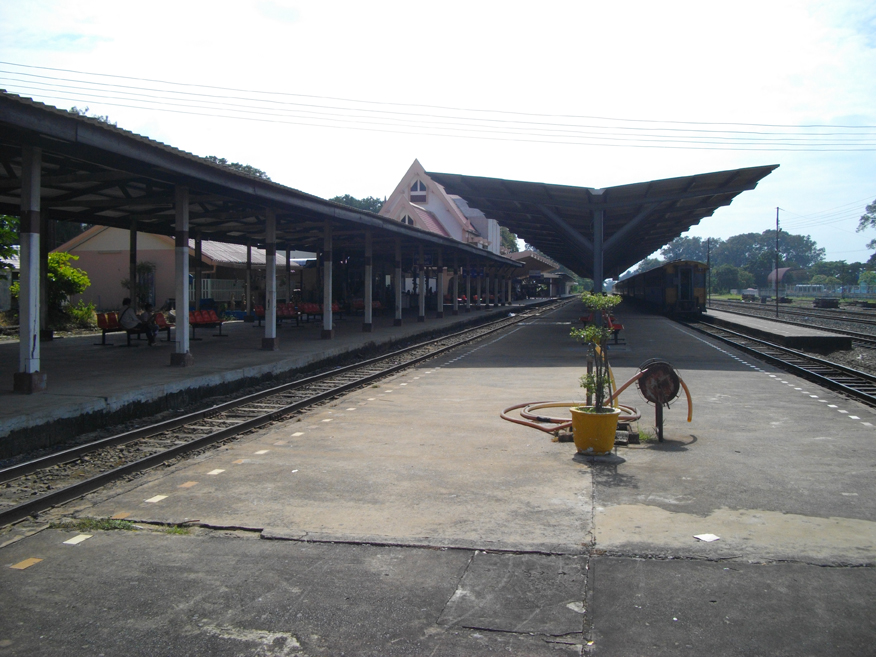 This loop line offers very scenic passage to the north through Lopburi Province, entering southern Chaiyaphum and connecting with the Nong Khai section of the Northeastern Line at Bua Yai Junction in northern Nakhon Ratchasima Province. In Lopburi Province it crosses the Pasak Cholasit Reservoir on spectacular concrete rail bridges.
This loop line offers very scenic passage to the north through Lopburi Province, entering southern Chaiyaphum and connecting with the Nong Khai section of the Northeastern Line at Bua Yai Junction in northern Nakhon Ratchasima Province. In Lopburi Province it crosses the Pasak Cholasit Reservoir on spectacular concrete rail bridges.
The main line continues to Nakhon Ratchasima where the Northeastern Line splits in two. From here one line travels east through the provinces of Buri Ram, Surin and Si Saket finally terminating in Ubon Ratchathani Province at Warin Chamrap Railway Station situated on the south bank of the River Moon opposite the provincial capital. The northern branch of the line, as mentioned , includes a connection to the loop line at Bua Yai Junction otherwise continuing out of the province into Khon Kaen and Udon Thani provinces terminating at Nong Khai on the Laotian border. Here a short section of track crosses the Mekong River into Laos serving the capital Vientiane.
Under the SRT master plan they intend to electrify the line to Nong Khai while converting all sections to dual track. In addition they would wish to build a rail link into Nakhon Phanom presumably from Khon Kaen Province running east to the Laotian border.
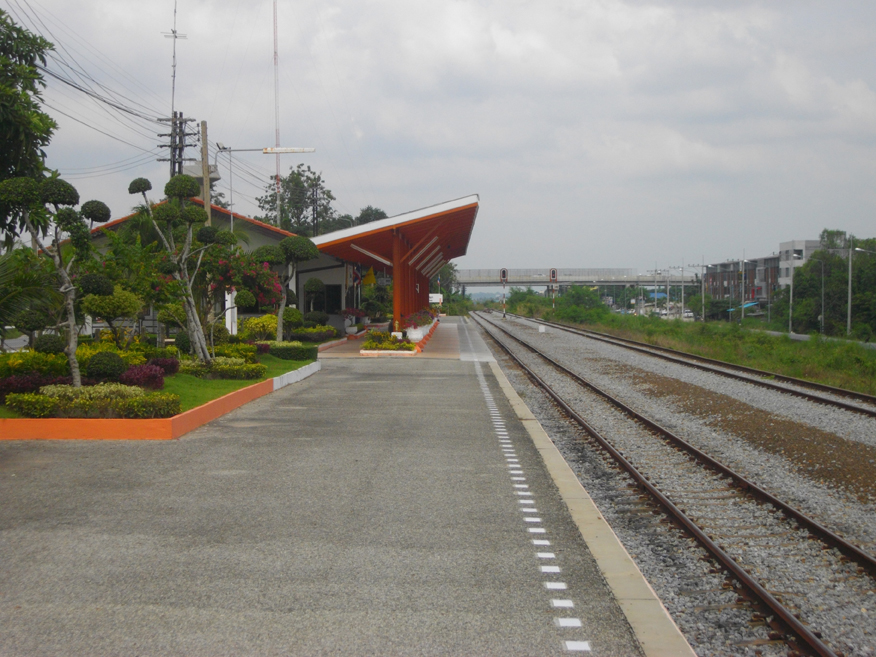
 Eastern Line……….The Eastern Line is also served from Hua Lamphong main station but is the only one of the four lines not to pass through Bang Sue Junction. Instead it bears right just a few kilometres north of Hua Lamphong Railway Station and follows the route east towards Suvarnabhumi Airport passing underneath the Airport Link terminal at Makasan. The route takes it into the highly industrialized eastern regions of the capital around Lat Krabang where it picks up freight traffic. Including oil refinery and storage facilities this area is crucial to Thailand’s economy. The line continues eastward to Chachoengsao Junction where the line splits. The southern commuter line runs through Chonburi and Pattaya terminating at Ban Phlu Ta Luang near the naval port of Sattahip. This is also an important route for freight. As Bangkok has no deep water facilities a huge container port is located at Leam Chabang.
Eastern Line……….The Eastern Line is also served from Hua Lamphong main station but is the only one of the four lines not to pass through Bang Sue Junction. Instead it bears right just a few kilometres north of Hua Lamphong Railway Station and follows the route east towards Suvarnabhumi Airport passing underneath the Airport Link terminal at Makasan. The route takes it into the highly industrialized eastern regions of the capital around Lat Krabang where it picks up freight traffic. Including oil refinery and storage facilities this area is crucial to Thailand’s economy. The line continues eastward to Chachoengsao Junction where the line splits. The southern commuter line runs through Chonburi and Pattaya terminating at Ban Phlu Ta Luang near the naval port of Sattahip. This is also an important route for freight. As Bangkok has no deep water facilities a huge container port is located at Leam Chabang.
Running north from Chachoengsao Junction the Eastern Line continues into Prachin Buri Province and onward to Sa Kaeo Province where it terminates at Aranyaprathet. There is just one further line to mention. Before the Eastern line leaves Chachoensao Province a loop line runs northward into Nakhon Nayok Province then into Saraburi Province terminating at the junction with the Northeastern Line at Kaeng Khoi Junction. This line however is used only for freight, bypassing the metropolis.
 Orientation (Mae Khlong Line)
Orientation (Mae Khlong Line)
As mentioned this line is not connected to the main network. This single line starts at Wongwian Yai Station and can be reached from a station of the same name on the BTS Silom Line extension. The line runs diesel railcars only but these are showing their age. The line terminates at Maha Chai Station which is a curiosity to tourists. The railway line runs straight into the market place and vendors display produce along the track. They know when a train is coming, removing their wares promptly, replacing them just as swiftly when the train departs. This covers only half of the line. Passengers can take a ferry boat across the Krachin River and pick up the line again at Ban Laem. A railcar can then be taken to Mae Klong (Samut Songkram) an area famous for its klongs (canals) and floating markets.
Orientation (Airport Rail Link, ARL)
The Airport Rail Link is owned by State Railway of Thailand (SRT) and operated by SRT subsidiary SRT Electrified Train (SRTET). Opened on August 23, 2010, the 28.6-km route is the fourth rapid transit line in Bangkok. Service consists of two Express Lines, a 15-minute nonstop service between the Makkasan city air terminal and Suvarnabhumi Airport or an 18-minute nonstop service from Phaya Thai. Along the route the City Line offers a commuter rail service with 8 stations.
The information above gives a very brief introduction to the railway system operated by the State Railway of Thailand. They have ambitious plans which seem to belie what is happening at present but the situation is constantly changing with plans already in place heading into the 3rd decade of this century.
SRT, the future
As we have seen the State Railway of Thailand is a monstrous state entity which through antiquated work practices and operations and lack of investment would not survive were it not for revenues from land and property ownership. Successive governments have been at a loss to turn things round since the philosophy has always been to subsidise the railway system to allow the less well off, cheap transportation between Bangkok and the provinces. However all this seems to have achieved is to encourage migration away from the provinces to the industrial, commercial and tourist areas of Thailand.
However the dilemma was addressed by the last government the Pheu Thai Party which proposed a major overall of the state railways. At the time it was considered too ambitious and flew in the face of the establishment. Two components of the plan came under strict scrutiny. First was the construction of several high-speed railway lines that would be electrified. Critics argued that the cost of rail travel would prove uncompetitive Thailand already has one of the most efficient airline networks in the Far East, servicing a number of cities that have no rail links. The second issue was all about how the project would be funded. The government had proposed using funds from a strategic reserve that was clearly not intended for infrastructure projects so the proposal was quickly vetoed. By the time of the military takeover in May 2014, no decision had therefore been taken. However the planners were not idle and the proposal was again considered. This led to a modified plan being drawn up which adopted most of the original proposals. It seemed that the original plan was not that ambitious after all.
To understand the problems facing the planners, two important factors needed to be addressed. The first was critical. For the best part of a hundred years Thailand has adopted a non-standard railway track gauge of 1 metre. In The US, Europe and crucially China the standard gauge is 1.435 metres. With trade with China ever more prominent in the modern world, Thailand is under extreme pressure to modernise its transport infrastructure. The second factor concerned the vast distances of the railway network covered only by a single track. The planners realised the important of freight traffic. It was clear that an efficient railway network would lead to a significant reduction in the transport costs per tonne compared with road transport and certainly that of air freight. Only transport on Thailand’s waterways was cheaper.
In a recent announcement the Transport Ministry reported that approval had been granted for the six main lines outlined in the original plan to be converted into dual-track but these would be all of one-metre guage. The six routes would total 887km. These routes include the 185km section from Jira junction in Nakhon Ratchasima to Khon Kaen, 167km from Prachuap Khiri Khan to Chumphon and 165km from Nakhon Pathom to Prachuap Khiri Khan’s Hua Hin district. Their construction was scheduled for 2015 to 2018.
Another three routes, which were scheduled to be built between 2016 and 2020, are the 132km section from Map Kabao in Saraburi to Nakhon Ratchasima, 148km from Lop Buri to Pak Nampho in Nakhon Sawan, and 90km from Prachuap Khiri Khan to Hua Hin.
It was later confirmed that two lines, considered pilot projects, would be converted to standard gauge and electrified. These were the 737-kilometre route linking Nong Khai, Khorat, Saraburi, Laem Chabang and Mab Ta Phut and the 655km stretch from Chiang Khong, Den Chai to Ban Phachi .
The choice of these two routes is interesting. The area around Laem Chabang and Mab Ta Phut is a development zone with deep sea port facilities, ideal for Chinese goods to be shipped to Malaysia and Singapore. However, the terminus at Nong Khai, opposite the Laotian capital of Vientiane leads absolutely nowhere as present. On the other hand at Chiang Khong a far easier route into China exists. Presumably the facility at Ban Phachi will allow trains to run down to Mab Ta Phut as this is one of the main junctions in Saraburi Province. If these projects go ahead it will be interesting how two railway track gauges can co-exist in the time it takes to transform the whole system. A number of key junctions will have to accommodate both gauges.
|
|
|
|
